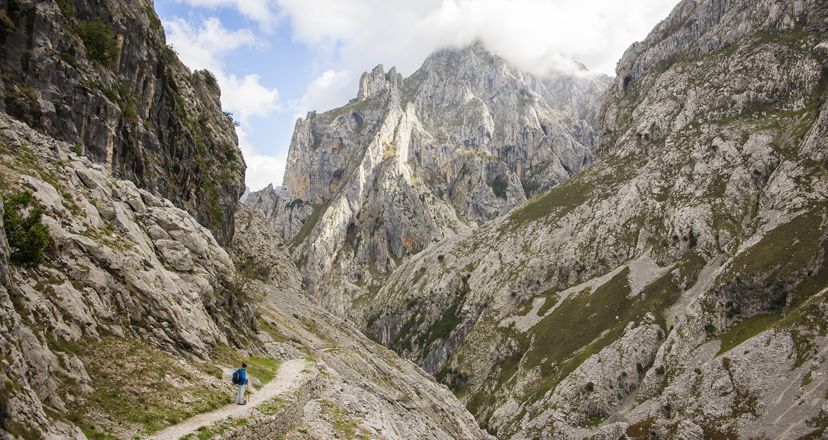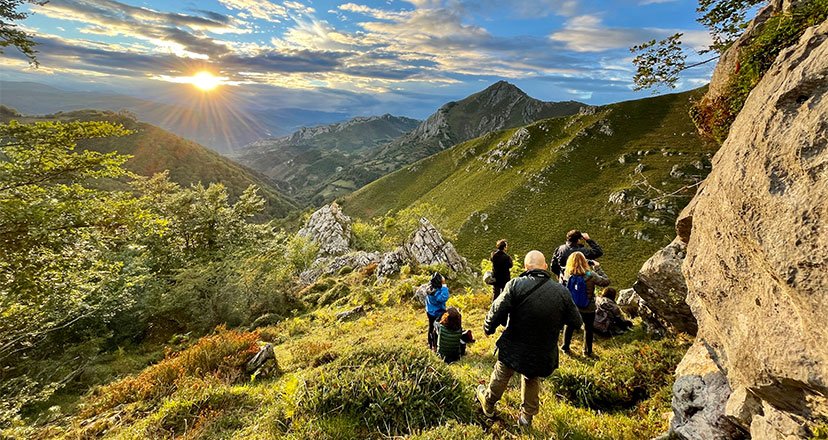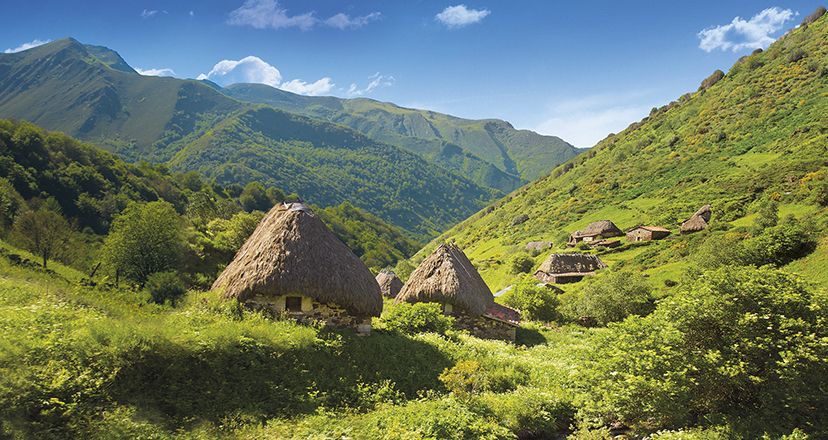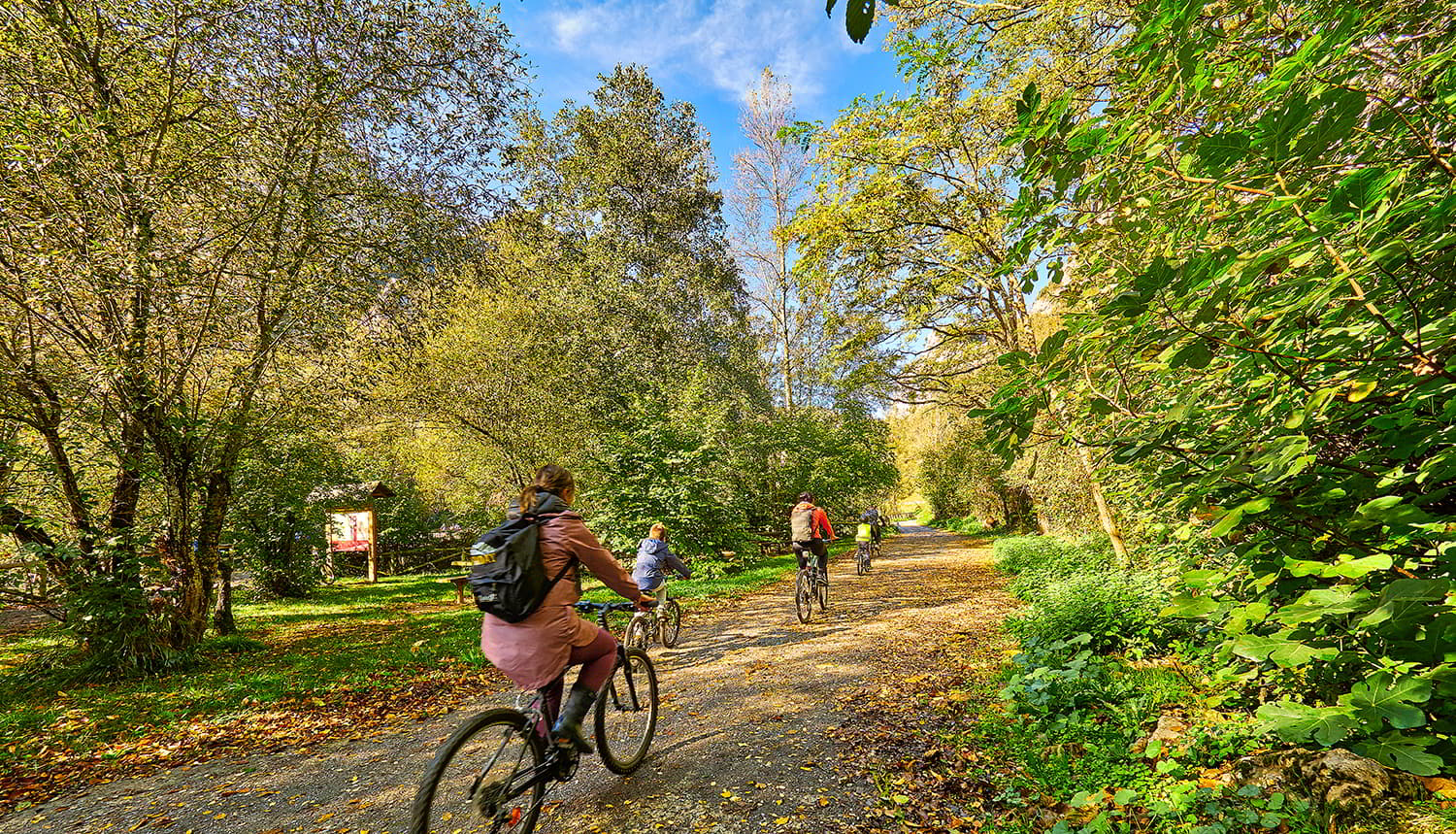Back 7 Fascinating routes through the forests of Asturias
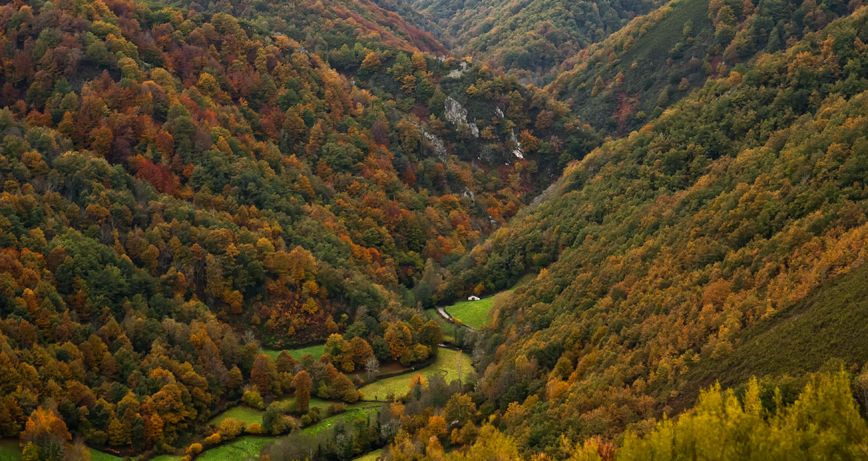
7 Fascinating routes through the forests of Asturias
Routes with forest are always a fascinating adventure, full of surprises. Asturias is a land of spectacular lushness for you to enjoy nature; here are 7 forest routes that will fill your mountaineering spirit!
A route in Asturias is a constant discovery, a small or great unforgettable adventure, a cascade of often indescribable sensations that can only be fully enjoyed if you experience them first hand.
¡Aquí tienen 7 rutas con bosque en Asturias que colmarán tu espíritu montañero!
Many surprises await us on a route in the heart of nature: skies with infinite nuances, changing lights throughout the day, the colours of the rock, the brightness of hundreds of greens, the singing of birds, the murmur of the trees, the harshness of a climb, the beauty of a panoramic view..., and almost omnipresent the forest, many forests.
Because Asturias is a wooded land, spectacularly leafy in some places. And the forests of Asturias are an inexhaustible source of resources and health in the broadest sense of the term.
The forest teaches you a thousand things about the animal and plant kingdom, the laws of nature, genetics, the origin of life, the climate... and above all, it helps you to feel better, to find yourself, to relax, to perceive the world, your world in harmony with Mother Nature. It clears your mind and helps you to think with agility, with transparency?
That's why, when you're on a route and you find yourself in a forest, it's a real blessing. If it's sunny, you'll find shade and relief from your hot flush; if it's raining, you'll feel the blanket of vegetation protecting you; if it's daytime, the forest will be full of life; if it's nighttime, the mystery is served...
Here are 7 forest routes in Asturias that will fill your mountaineering spirit!
Brañagallones, the great find
The Brañagallones Route is a chain of surprises and discoveries. The route has an idyllic start, on the banks of the river Nalón, in the beautiful village of Bezanes, in the council of Caso.
A winding and steep path will set the course until you reach the longed-for goal. Just two kilometres from the start of your adventure, you will come to the Texu La Oración viewpoint, and you will be able to enjoy the first panoramic views of Bezanes, the Nalón basin and the Cascayón peak, and a little further on you will see the Cantu del Oso, which rises impressively above Brañagallones.
As you continue along the route, you will see the Monasterio river valley, cross the Crestón tunnel, and then you will enter one of the most spectacular forests in the Redes Nature Reserve. And as a fantastic climax, after more than 10 kilometres of walking, you will reach Brañagallones, which is sure to be a great find.
In this famous "braña de los gallones" (the capercaillies), you will be able to see the traces of a time when there were abundant capercaillie roosts (places for displaying the males during the rutting season). You will find yourself surrounded by beech forests with blueberry trees, in the middle of a peaceful place, and by what was once a glacial cirque.
You will have completed one of those unforgettable forest routes in a Biosphere Reserve such as the Redes Nature Reserve!
La Senda de los Molinos, a natural delight in Bimenes
Bimenes has always been a land of water and windmills. Of ethnography and rural life. Of countryside and mining. So the Senda de los Molinos will meet all your expectations.
This windmill and forest itinerary starts in the village of Rozaes, and from there you will head towards Segredal. There you will take a path on the left, and you will soon find yourself in the forest. A few minutes after crossing the river, you will come across the first mills: Matilde's, Barrial's, Flora's, Ferreru's and Máxima's mills.
As you walk amidst the green foliage, you will catch a glimpse of the imposing peaks of the Sierra de Peñamayor, and once again you will come across more mills. This time it will be the Milio and Fermina mills. Moreover, in the latter, which was restored for this purpose, you will learn about the instruments and mechanisms of the great Asturian milling tradition, which forms part of the ancestral cultural heritage of the Natural Paradise.
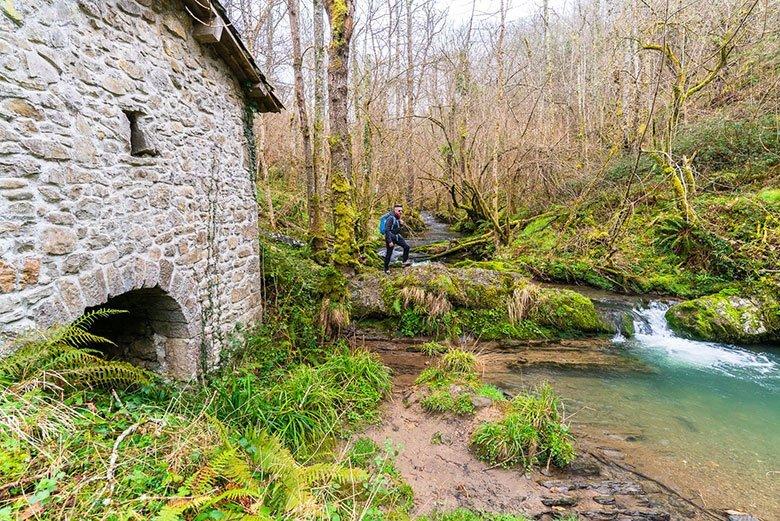
Nearby, there is a table and a bench, ideal for resting and recharging your batteries. And little by little, you will reach the last mill, that of Honorio, and you will soon reach the village of Melendreros, which will be the end of the route.
You will have completed a wonderful route that perfectly combines the forest and the mills!
Moal, a forest that is the gateway to another forest
You will find the Moal Forest Route fascinating, not only because of the beauty of the places you will walk through, but also because you will realise that you are in a forest that is the gateway to the largest oak forest in Europe: the Muniellos Forest.
This is an easy and pleasant route, immersed all the time in one of the 7 Biosphere Reserves of Asturias: the Natural Park of Fuentes del Narcea, Degaña and Ibias.
The route starts in the village of Mual, which was an Exemplary Village of Asturias in 2018, and which is a place of hospitable people, always ready to attend to visitors.
In the vicinity of the village, just across the river, there is an impressive chestnut forest where you will see the typical corripas (circular stone constructions used to store the hedgehogs of the chestnut tree and let them "cure" until their fruit comes off easily).
Once you have left the village of Mual, the path runs parallel to the Muniellos river, crossing the meadows that occupy the river plain and leaving the chestnut woods behind. The route continues accompanied by oak and beech woods that cover the slopes on both sides. You can also see "cortinos" (circular stone constructions whose mission is to protect the beehives from attacks by bears) all along the route.
Continue along the route along the main track, ignoring any path that may start from it, until you reach the entrance gate to the Muniellos Integral Nature Reserve, a real jewel in the Asturian natural heritage, a refuge for emblematic species such as the brown bear and the Cantabrian capercaillie. You will then take a path on the left, which continues uphill between oak and chestnut trees, first, and then leads to a beautiful beech forest.
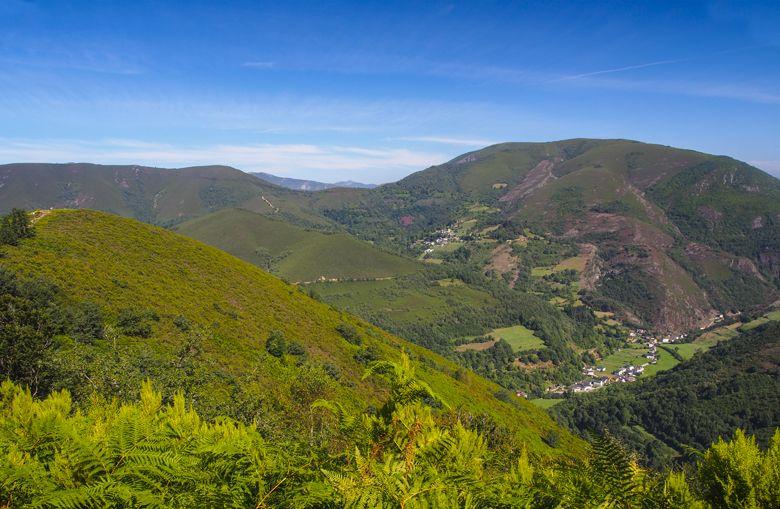
After crossing the beech forest, you will ascend to the Montecín viewpoint, which you can see in front of you. From the viewpoint you can see the village of Moal, the Connio pass and the lower part of the Muniellos Integral Nature Reserve.
Then you will return to the village of Mual, after a marvellous route through the woods ...
Muniellos, the forest of forests
The Muniellos Integral Nature Reserve is a completely unspoilt natural area that is home to the largest oak forest in Spain and one of the best preserved in Europe. It includes Monte de Muniellos and La Vilieḷḷḷa, in Cangas del Narcea, and Valdebois, in Ibias.
The Muniellos Forest is a magical, ever-changing place, a clear example of the Asturian paradise at all times of the year. Among other plant species, there are oaks of different species and up to six metres in diameter, beech and birch trees, which are dotted with the continuous presence of holly and yew trees, perennial kings of the Muniellos autumn.
This fantastic forest, full of legends and Asturian mythology, sits on a Palaeozoic substratum some 500 million years old; here you can see ancient glacial cirques and lleronas, or crumbled quartzite cliffs. The glacial origin of Muniellos is attested by the famous lagoons of the Pico de la Candanosa, four steps of water, of enigmatic beauty, which are hidden among valleys, paths and peaks. The ascent to these lakes: La Peña, Grande, Fonda and La Isla is one of the most interesting routes for hiking enthusiasts, and will be one of the natural landmarks that will most attract your attention.
In addition, the Muniellos or Tablizas River, which crosses the entire forest, will accompany you all the time on your route.
You will find nature in an exceptional state of conservation, and for this reason visits to this forest are restricted to groups of 20 people per day, and bookings must be made in advance on the official website of the Government of the Principality of Asturias www.asturias.es.
Teixóis, all the magic of western Asturias
The O Teixo to Os Teixóis route starts at the Teixo pass, in Taramundi, between the emblematic peaks of Ouroso and Busnovo. You will head towards the village of Santa Marina, and on the path that will lead you there, you will cross a 'castañéu', which will be your first contact with the forest on this wonderful route.
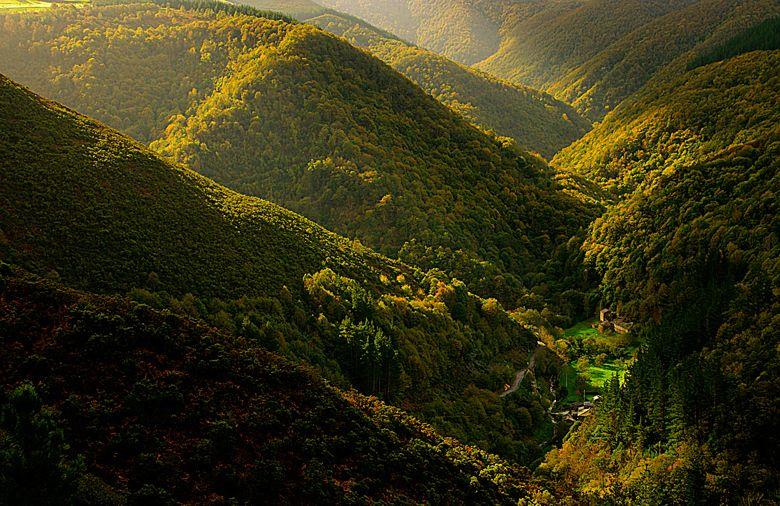
In the village of Santa Marina, you will find numerous examples of the rural architecture characteristic of western Asturias, with its hermetic volumes, masonry walls with exposed stone and slate roofs. From Santa Marina you will go to the hamlet of Almallos, and from there, between meadows and chestnut groves, you will reach the road that links Taramundi with Veigas, taking a path that leads to the Ethnographic Ensemble of Os Teixóis, a magnificent example of what in the 18th century was a thriving industry in the whole of Western Asturias. Os Teixóis brings together a whole series of water-powered devices: a mill, a forge's mallet, a fulling mill for processing wool, whetstones and even a primitive power station.
Once you have visited Os Teixóis, you will walk towards the nearby village of Las Mestas, along a path that runs alongside a stream. On this final stretch of the route, you will find the still identifiable 'carboeiras' which, fed by the abundant oak trees in the area, produced the charcoal consumed in the many forges that once existed. Once in Las Mestas, a track will lead you back to Teixo.
This is a dream route through forests, streams, hydraulic mills and the entire history of western Asturias engraved on every stone along the way.
Peloño, the most colourful forest in the world
The Peloño Forest, in Ponga, is a tunnel of vegetation, nature and landscape; a tunnel of tranquillity, history and ethnography. Peloño is a large beech forest that you will walk along a track of about sixteen kilometres until you reach the Arcenorio plain, a large esplanade dotted with shepherds' huts, where only the livestock, the inhabitants and the hikers break the serenity of the place.
In the middle of such a beautiful esplanade, the chapel of Arcenorio, and on the way to it, the beech forest offers marvellous views of the Picos de Europa. On arrival at the plain, we are greeted by a myriad of yellow gentians, and halfway along the route you can take a detour to visit the Roblón de Bustiello, a gigantic sessile oak that is well worth seeing, and in the Guaranga, barely two kilometres from Arcenorio, you can look back and see the trenches of the civil war, half hidden by the vegetation.
Vultures, woodpeckers and jays stand out among the fauna on this beautiful and essential route.
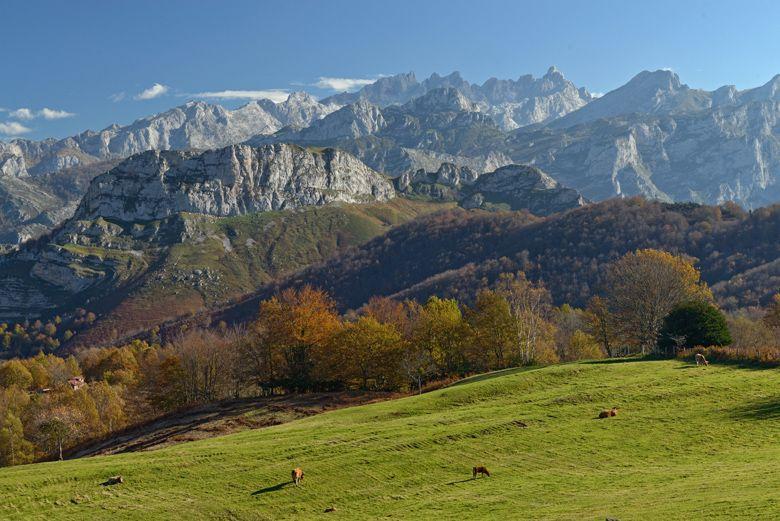
However, to do this route you will first have to get to San Xuan/San Juan de Beleño or Viego, and from there to the viewpoint of Les Bedules, where you will start this fantastic itinerary.
From this viewpoint you will start walking along a track, which is the one that goes into the forest, although at the beginning it is surrounded by pastures. This path is known as the Camín de los Arrieros and continues to Collado Granceno. And at this pass you will already have fantastic views of the Peloño forest.
The Peloño forest route is a great natural adventure!
Montegrande beech forest, pure plant poetry
The route of the Montegrande Beech Forest and the Xiblu Waterfall is one of the best examples in Asturias of a natural itinerary where a forest and a waterfall are perfectly combined.
The route starts at the car park of La Puerca, shortly after passing the village of Parmu/Páramo. It is a simple and comfortable walk along a wide track, which will allow you to discover secrets such as the occasional mine shaft, where you can glimpse coal galleries that have now been sealed. Also, almost at the beginning of the path you will find the lepers' spring, so called because in the past these sick people used to seek healing in these waters...
You will feel yourself between history and legend, and among lichen-covered trees. And of course, breathing one of the purest airs you can imagine.
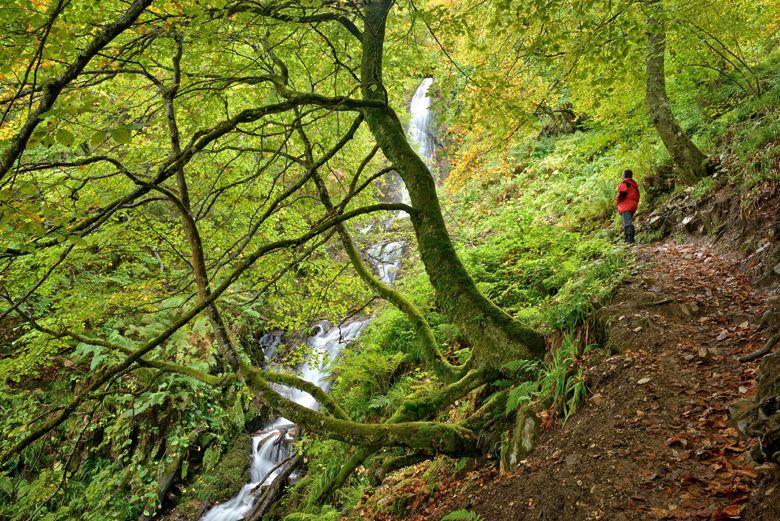
After walking several kilometres up the forest (some uphill), and in the opposite direction to the flow of the river, you will come to the most beautiful climax you could hope for: the Xiblu Waterfall. This is actually a set of three waterfalls with a total of 100 metres of water falling wildly down the mountain, creating a beautiful scene. In addition, when the wind blows in a certain direction, it generates a curious whistling sound, a phenomenon that gives the waterfall its name...
So to enjoy the forests of Asturias, and all the beauty and immensity of places and corners, there is nothing better than staying in the network of rural establishments (houses and flats), located in dream places with the most natural surroundings, and which are part of the Aldeas Asturias Rural Quality brand!
A route in Asturias is a constant discovery, a small or great unforgettable adventure, a cascade of often indescribable sensations that can only be fully enjoyed if you experience them first hand.
Many surprises await us on a route in the heart of nature: skies with infinite nuances, changing lights throughout the day, the colours of the rock, the brightness of hundreds of greens, the singing of birds, the murmur of the trees, the harshness of a climb, the beauty of a panoramic view..., and the almost omnipresent forest, many forests.
Because Asturias is a wooded land, spectacularly leafy in some places. And the forests of Asturias are an inexhaustible source of resources and health in the broadest sense of the term.
The forest teaches you a thousand things about the animal and plant kingdom, the laws of nature, genetics, the origin of life, the climate... and above all, it helps you to feel better, to find yourself, to relax, to perceive the world, your world in harmony with Mother Nature. It clears your mind and helps you to think with agility, with transparency?
That's why, when you're on a route and you find yourself in a forest, it's a real blessing. If it's sunny, you'll find shade and relief from your hot flush; if it's raining, you'll feel the blanket of vegetation protecting you; if it's daytime, the forest will be full of life; if it's night, the mystery is served...
Here are 7 forest routes in Asturias that will fill your mountaineering spirit!
Brañagallones, the great discovery
The Brañagallones Route is a chain of surprises and discoveries. The route has an idyllic start, on the banks of the river Nalón, in the beautiful village of Bezanes, in the council of Caso.
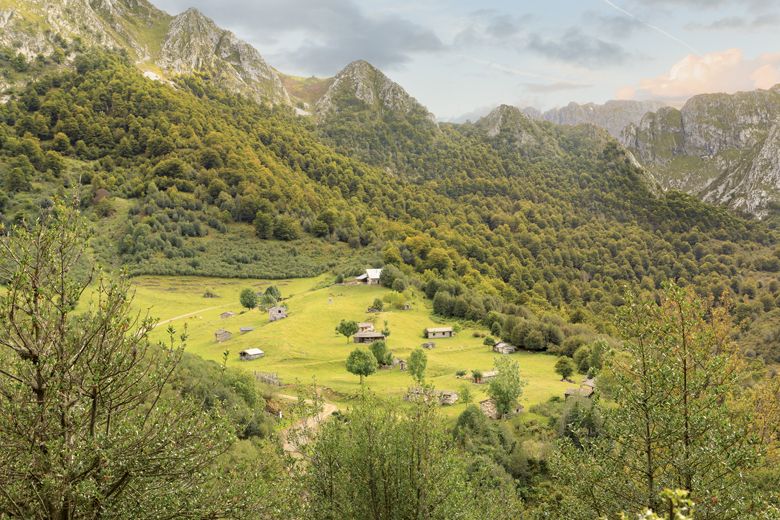
A steep, winding path will set the course for you until you reach the longed-for goal. Just two kilometres from the start of your adventure, you will find the Texu La Oración viewpoint, and you will be able to enjoy the first panoramic views of Bezanes, the Nalón basin and the Cascayón peak, and a little further on you will see the Cantu del Oso, which rises impressively above Brañagallones.
As you continue along the route, you will see the Monasterio river valley, cross the Crestón tunnel, and then enter one of the most spectacular forests in the Redes Nature Reserve. And as a fantastic climax, after more than 10 kilometres of walking, you will reach Brañagallones, which is sure to be a great find.
In this famous "braña de los gallones" (the capercaillies), you will be able to see the traces of a time when there were abundant capercaillie roosts (places for displaying the males during the rutting season). You will find yourself surrounded by beech forests with blueberry trees, in the middle of a peaceful place, and by what was once a glacial cirque.
You will have completed one of those unforgettable forest routes in a Biosphere Reserve such as the Redes Nature Reserve!
La Senda de los Molinos, a natural delight in Bimenes
Bimenes has always been a land of water and windmills. Of ethnography and rural life. Of countryside and mining. So the Senda de los Molinos will meet all your expectations.
This windmill and forest itinerary starts in the village of Rozaes, and from there you will head towards Segredal. There you will take a path on the left, and you will soon find yourself in the forest. A few minutes after crossing the river, you will come across the first mills: Matilde's, Barrial's, Flora's, Ferreru's and Máxima's mills.
As you walk amidst the green foliage, you will catch a glimpse of the imposing peaks of the Sierra de Peñamayor, and once again you will come across more mills. This time it will be the Milio and Fermina mills. In the latter, which was restored for this purpose, you will learn about the instruments and mechanisms of the great Asturian milling tradition, which forms part of the ancestral cultural heritage of the Natural Paradise.
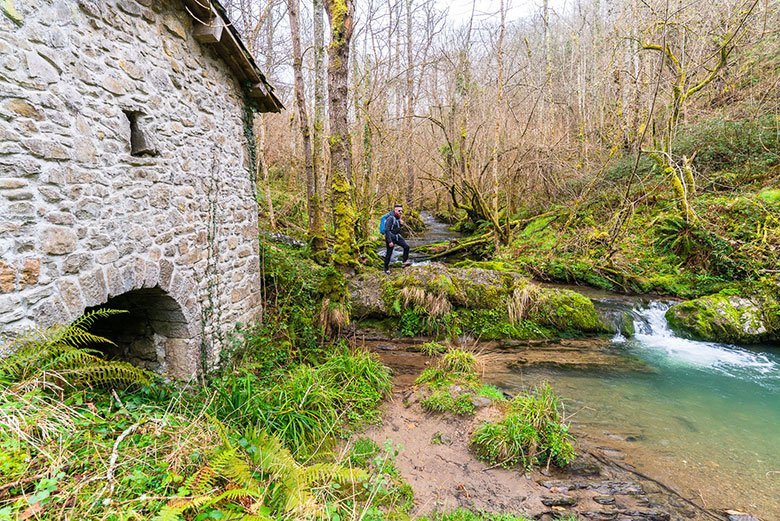
Nearby, there is a table and a bench, ideal for resting and recharging your batteries. And little by little, you will reach the last mill, Honorio's, and you will soon reach the village of Melendreros, which will be the end of the route.
You will have completed a marvellous route that perfectly combines forest and mills!
Moal, a forest that is the gateway to another forest
You will find the Moal Forest Route fascinating, not only because of the beauty of the places you will visit, but also because you will realise that you are in a forest that is the gateway to the largest oak forest in Europe: the Muniellos Forest.
This is an easy and pleasant route, immersed all the time in one of the 7 Biosphere Reserves of Asturias: the Natural Park of Fuentes del Narcea, Degaña and Ibias.
The route starts in the village of Mual, which was Exemplary Village of Asturias in 2018, and which is a place of hospitable people, always ready to attend to visitors.
In the vicinity of the village, just across the river, there is an impressive chestnut forest where you will see the typical corripas (circular stone constructions used to store the hedgehogs of the chestnut tree and let them "cure" until their fruit comes off easily).
Once you have left the village of Mual, the path runs parallel to the Muniellos river, crossing the meadows that occupy its river plain, and leaving the chestnut woods behind. The route continues accompanied by oak and beech woods that cover the slopes on both sides. You can also see "cortinos" (circular stone constructions whose mission is to protect the beehives from attacks by bears) all along the route.
Continue along the route along the main track, ignoring any path that may start from it, until you reach the entrance gate to the Muniellos Integral Nature Reserve, a real jewel in the Asturian natural heritage, a refuge for emblematic species such as the brown bear and the Cantabrian capercaillie. You will then take a path on the left, which continues uphill between oak and chestnut trees, first, and then leads to a beautiful beech forest.
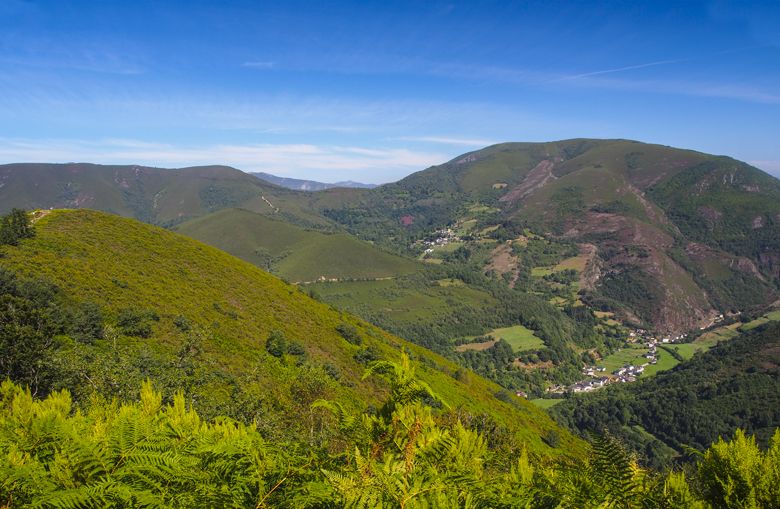
After crossing the beech forest, you will ascend towards the Montecín viewpoint, which you can see in front of you. From the viewpoint you can see the village of Moal, the Connio pass and the lower part of the Muniellos Integral Nature Reserve.
Then you will return to the village of Mual, after a marvellous route through the woods ...
Muniellos, the forest of forests
The Muniellos Integral Nature Reserve is a completely unspoilt natural area that is home to the largest oak forest in Spain and one of the best preserved in Europe. It includes Monte de Muniellos and La Vilieḷḷḷa, in Cangas del Narcea, and Valdebois, in Ibias.
The Muniellos Forest is a magical, ever-changing place, a clear example of the Asturian paradise at all times of the year. Among other plant species, there are oaks of different species and up to six metres in diameter, beech and birch trees, which are dotted with the continuous presence of holly and yew trees, the perennial kings of the Muniellos autumn.
This fantastic forest, full of legends and Asturian mythology, sits on a Palaeozoic substratum some 500 million years old; here you can see ancient glacial cirques and lleronas, or crumbled quartzite cliffs. The glacial origin of Muniellos is attested by the famous lagoons of the Pico de la Candanosa, four steps of water, of enigmatic beauty, which are hidden among valleys, paths and peaks. The ascent to these lakes: La Peña, Grande, Fonda and La Isla is one of the most interesting routes for hiking enthusiasts, and will be one of the natural landmarks that will attract your attention.
In addition, the Muniellos or Tablizas River, which crosses the entire forest, will accompany you all the time on your route.
You will find nature in an exceptional state of conservation, which is why visits to this forest are restricted to groups of 20 people per day, and bookings must be made in advance on the official website of the Government of the Principality of Asturias www.asturias.es.
Teixóis, all the magic of western Asturias
The O Teixo to Os Teixóis route starts at the Teixo pass, in Taramundi, between the emblematic peaks of Ouroso and Busnovo. You will head towards the village of Santa Marina, and on the path that will lead you to it, you will cross a 'castañéu', being your first contact with the forest in this wonderful route.
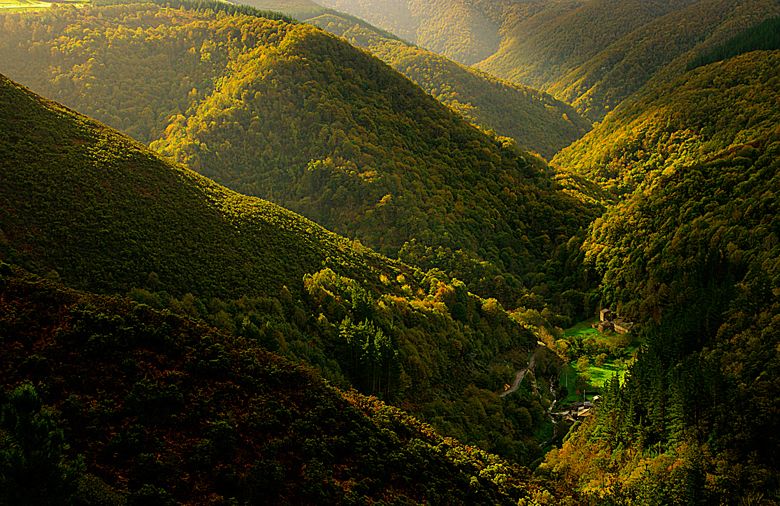
In the village of Santa Marina, you will find numerous examples of the characteristic rural architecture of western Asturias, with its hermetic volumes, its masonry walls with exposed stone and its slate roofs. From Santa Marina you will go to the hamlet of Almallos, and from there, between meadows and chestnut groves, you will reach the road that links Taramundi with Veigas, taking a path that leads to the Ethnographic Ensemble of Os Teixóis, a magnificent example of what in the 18th century was a thriving industry in the whole of Western Asturias. Os Teixóis brings together a whole series of water-powered devices: a mill, a forge's mallet, a fulling mill for processing wool, whetstones and even a primitive power station.
Once you have visited Os Teixóis, you will walk towards the nearby village of Las Mestas, along a path that runs alongside a stream. On this final stretch of the route, you will find the still identifiable 'carboeiras' which, fed by the abundant oak trees in the area, produced the charcoal consumed in the many forges that once existed. Once in Las Mestas, a track will lead you back to Teixo.
A dream route through forests, streams, water mills and the entire history of western Asturias engraved on every stone along the way.
Peloño, the most colourful forest in the world
The Peloño Forest, in Ponga, is a tunnel of vegetation, nature and landscape; a tunnel of tranquillity, history and ethnography. Peloño is a large beech forest that you will walk along a track of about sixteen kilometres until you reach the Arcenorio plain, a large esplanade dotted with shepherds' huts, where only the livestock, the inhabitants and the hikers break the serenity of the place.
In the middle of such a beautiful esplanade, the chapel of Arcenorio, and on the way to it, the beech forest offers marvellous views of the Picos de Europa. On arrival at the plain, we are greeted by a myriad of yellow gentians, and halfway along the route you can take a detour to visit the Roblón de Bustiello, a gigantic sessile oak that is well worth seeing, and in the Guaranga, barely two kilometres from Arcenorio, you can look back and see the trenches of the civil war, half hidden by the vegetation.
Vultures, woodpeckers and jays are among the fauna on this beautiful and essential route.
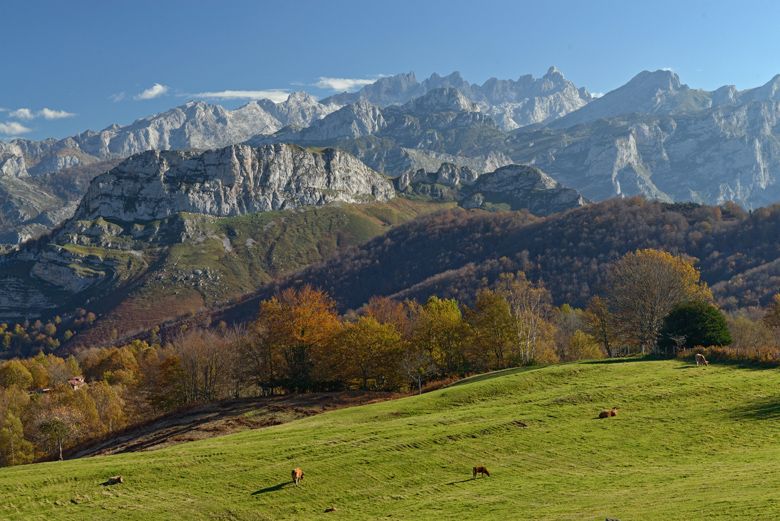
However, to do this route you will first have to get to San Xuan/San Juan de Beleño or Viego, and from there to the viewpoint of Les Bedules, where you will start this fantastic itinerary.
From this viewpoint you will start walking along a track, which is the one that goes into the forest, although at the beginning it is surrounded by pastures. This path is known as the Camín de los Arrieros and continues to Collado Granceno. And at this pass you will already have fantastic views of the Peloño forest.
The Peloño forest route is a great natural adventure!
Montegrande beech forest, pure plant poetry
The Montegrande beech forest and Xiblu waterfall route is one of the best examples in Asturias of a natural itinerary where a forest and a waterfall are perfectly combined.
The route starts in the car park of La Puerca, shortly after passing the village of Parmu/Páramo. It is a simple and comfortable walk along a wide track, which will allow you to discover secrets such as the occasional mine shaft, where you can glimpse coal galleries that have now been sealed. Also, almost at the beginning of the path you will find the leper's spring, so called because in the past these sick people used to seek healing in these waters...
You will feel yourself between history and legend, and among lichen-covered trees. And of course, breathing one of the purest airs you can imagine.
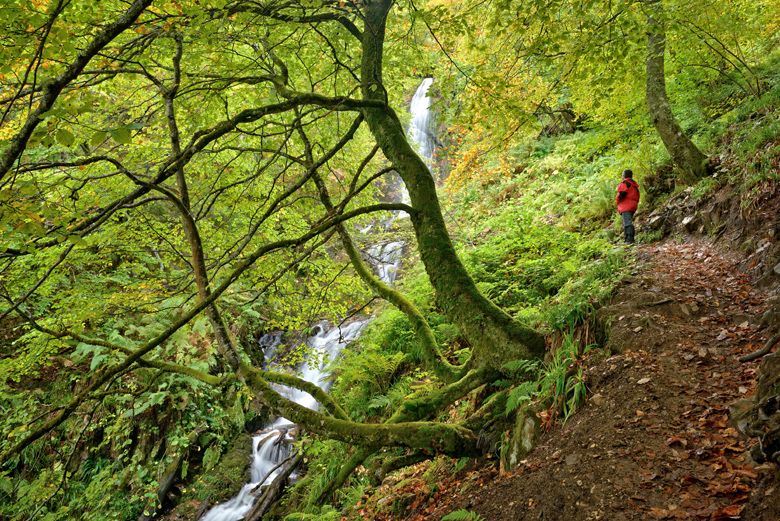
After walking several kilometres further on in the forest (some uphill), and in the opposite direction to the flow of the river, you will come to the most beautiful culmination you could hope for: the Xiblu Waterfall. This is actually a set of three waterfalls with a total of 100 metres of water falling wildly down the mountain, creating a beautiful scene. In addition, when the wind blows in a certain direction, it generates a curious whistling sound, a phenomenon that gives the waterfall its name...
So to enjoy the forests of Asturias, and all the beauty and immensity of places and corners, there is nothing better than staying in the network of rural establishments (houses and flats), located in dream places with the most natural surroundings, and which are part of the Aldeas Asturias Rural Quality brand!
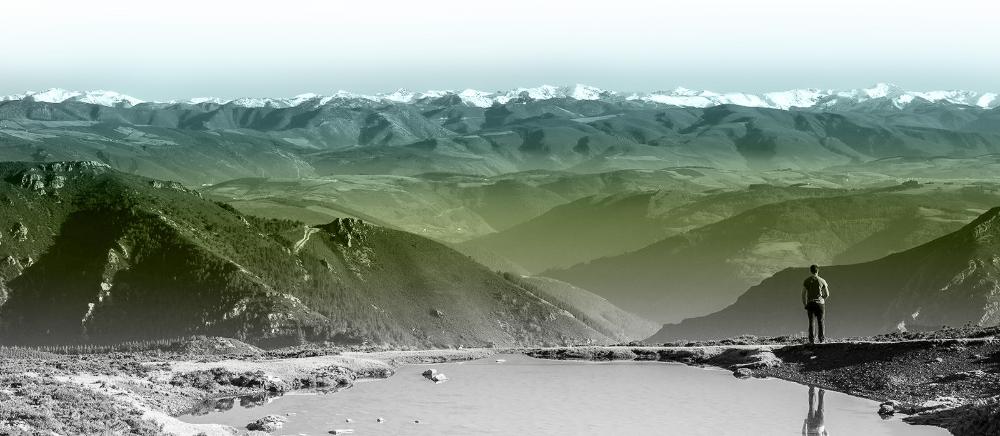
Subscribe to our newsletter and take advantage of offers, discounts, and news
Subscribe

